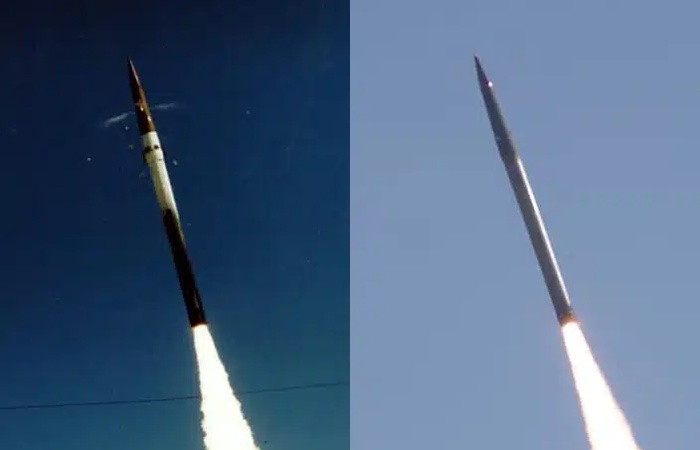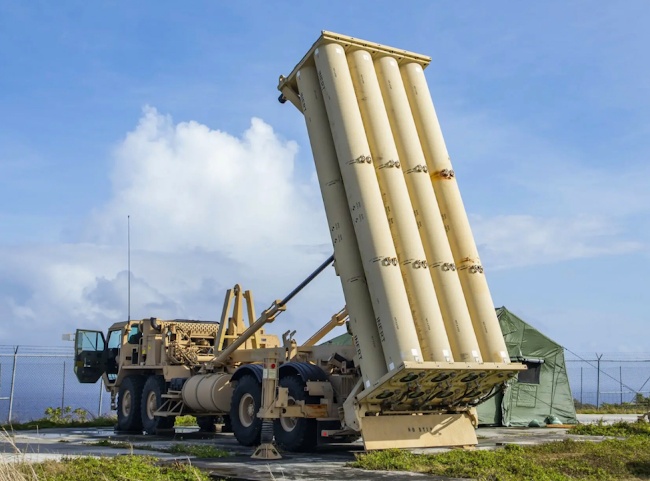Lockheed Martin THAAD
The THAAD (Terminal High Altitude Area Defense - originally "Theater High Altitude Area Defense", renamed in Feb. 2004) missile defense system was first proposed in 1987, and in 1990 the formal request for proposals was submitted to the industry. In September 1992, the U.S. Army selected Lockheed Martin as prime contractor for THAAD development, and the first THAAD flight test occurred in April 1995.
A THAAD battery consists of six M1120 launch trucks with 8 missiles each, two mobile tactical operations centers, and the AN/TPY-2 Ground-Based Radar (GBR). The GBR is employed for surveillance at ranges of up to 1000 km (600 miles), target identification and target tracking. Targeting information is uploaded to the missile immediately before launch and continuously updated during the flight. The THAAD missile is powered by a single stage solid-propellant rocket motor with thrust vectoring. After burnout, the booster is separated from the kill vehicle (KV), which continues to the interception point. For exo-atmospheric manoeuvering, the KV is equipped with a Boeing-developed liquid DACS (Divert and Attitude Control System). In the terminal intercept phase, the KV is guided by an InSb staring FPA (Focal Plane Array) infrared seeker, whose window is protected in the initial flight phase by a clamshell protection shroud. The KV has no explosive warhead and destroys the target by direct impact. The THAAD can intercept ballistic missile targets at altitudes up to 150 km (93 miles) at a range of more than 200 km (125 miles).
 |
| Photo: Missile Defense Agency |
| THAAD (left: prototype; right: EMD) |
Between 21 April 1995 and 2 August 1999, a total of 11 THAAD flight tests occurred. The initial tests validated propulsion and seeker systems, and the first actual intercept was attempted in the 4th flight on 13 December 1995. However, the test failed and the first successful interception (a Hera ballistic target) actually did not occur before the 10th flight on 10 June 1999! The reasons for the preceding six failures were various, and included failures in the propulsion system, stage separation, seeker soft- and hardware, and the kill vehicle's DACS. The 11th test was also successful, but the system's bad test record of course significantly delayed the program.
 |
| Photo: Lockheed Martin |
| THAAD |
In late 1999, it was decided to enter the EMD (Engineering and Manufacturing Development) phase of the THAAD program, and the EMD contract was awarded to Lockheed Martin in June 2000. The first EMD flight test occurred on 22 November 2005, and tested missile launch, flight control, and KV separation and control, but did not involve an actual target. Until March 2009, a total of 11 THAAD tests, including six actual intercepts, had been conducted, all of which were successful. In 2012, a test showed the successful integration of THAAD and Patriot PAC-3 in a common ballistic missile defense environment.
 |
| Photo: Sgt. 1st Class David T. Chapman / US Army |
| M1120 THAAD Launcher |
In January 2007, Lockheed Martin received the first production contract for THAAD, covering 48 missiles, six launchers and two fire control and communications units. In May 2008, the Army's first THAAD battery was formally activated. The THAAD program is currently managed by the Missile Defense Agency, with the Army as the operator of the missile systems. By 2023, the U.S. Army had 7 active THAAD batteries, with at least one more planned.
Designation Note: No confirmed formal alphanumeric designation for the THAAD missile is known. While there are a few isolated references in Army logistics and training files to a "Guided Missile, Intercept-Aerial, THAAD MIM-401" and "Guided missile sub-system, intercept-aerial MIM-401B" (and -401C), DOD MDS records up until January 2025 don't include any MIM-401 designation. Therefore, it must be assumed that MIM-401 was never officially allocated to THAAD. Also, the number 401 is suspiciously close to XM400, the official Army nomenclature for the Patriot PAC-3 MSE missile. It is relatively likely, that the THAAD missile was to be designated XM401, and that this was somehow semi-officially converted to MIM-401, to look like a regular guided missile MDS.
Specifications
Note: Data given by several sources show slight variations. Figures given below may therefore be inaccurate!
Data for THAAD:
| Length | 6.17 m (20 ft 3 in) |
| Diameter | booster: 34 cm (13.4 in); KV: 37 cm (14.5 in) |
| Weight | 900 kg (2000 lb) |
| Speed | 2800 m/s (9200 fps) |
| Ceiling | 150 km (93 miles) |
| Range | > 200 km (125 miles) |
| Propulsion | Pratt & Whitney solid-fueled rocket |
| Warhead | none ("hit-to-kill") |
Main Sources
[1] Hajime Ozu: "Missile 2000 - Reference Guide to World Missile Systems", Shinkigensha, 2000
[2] Lockheed
Martin Missiles and Fire Control Website
[3] GlobalSecurity.org Website
[4] Army Technology: THAAD Theatre High Altitude Area Defense
– Missile System
[5] Wikipedia: Terminal High Altitude Area Defense
Back to Directory of U.S. Military Rockets and Missiles, Appendix 4
Last Updated: 28 March 2025